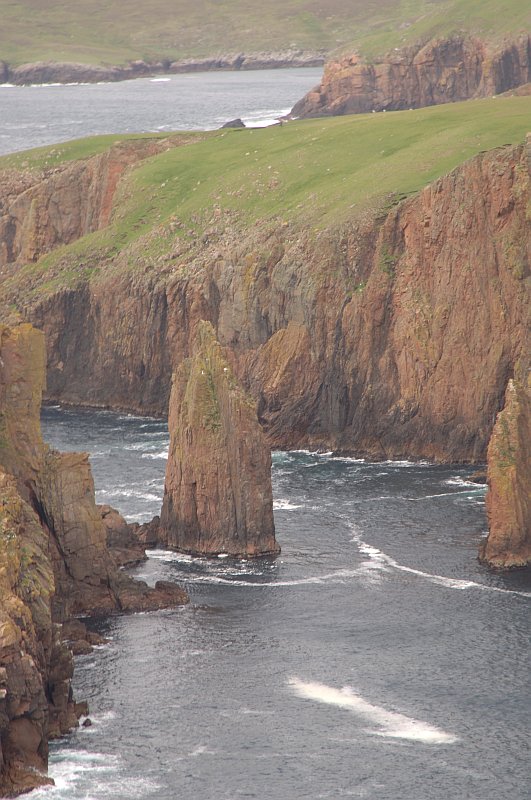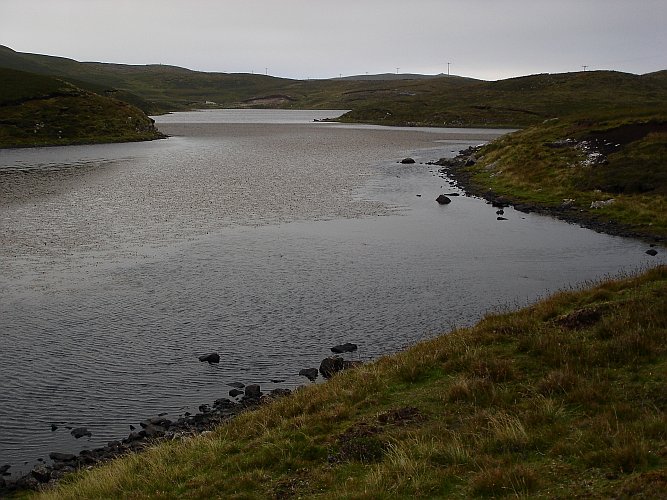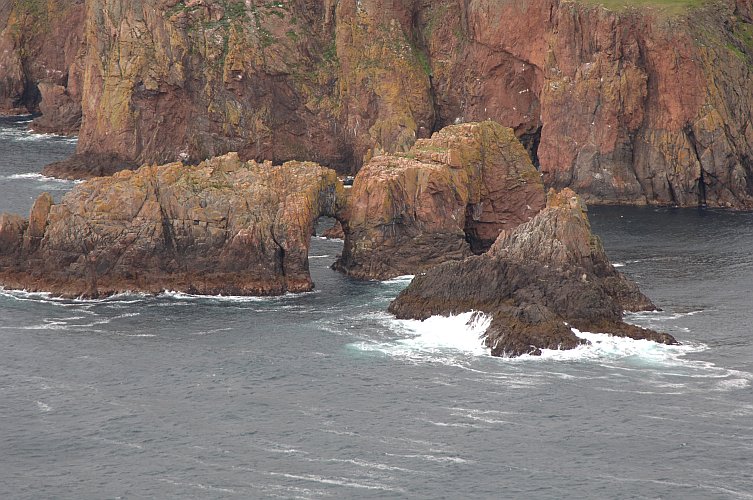West Mainland: Welcome to the Sunny Side of Shetland
“West is best”. It’s true – many a day when the east coast of Shetland is smothered in sea fog, the Westside is gloriously sunny. It happens particularly in summer, when south-easterly winds pick up moisture from the North Sea: as the clammy air passes over the hills of Shetland it warms and dries, clearing away the mist.
 Sandsting Cliffs
Sandsting Cliffs
 The West Mainland offers many miles of hill and coastal walks, excellent birding, seal-watching and otter-spotting, great angling and some fascinating historical and archaeological sites.
The West Mainland offers many miles of hill and coastal walks, excellent birding, seal-watching and otter-spotting, great angling and some fascinating historical and archaeological sites.
There are hundreds of freshwater lochs, most of them in hollows carved by glaciers out of the granite and sandstone rocks. The lochs and the burns linking them to the sea are home to trout, ducks, wading birds and plants such as Bogbean and white Water Lily.
This is a classic “drowned coastline”, flooded by the sea at the end of the Ice Age, some 12,000 years ago. The shorescape varies from the dramatic cliffs of the outer coast to long voes (sea inlets), which extend far into the heathery hills and green croftland. Whatever the wind direction, you can always find a sheltered beach.
A Crofting Tradition
The Westside is a largely unspoilt corner of Shetland, only indirectly affected by the oil developments of the past 20 years. Very much a traditional crofting community, this is also one of the main centres of the seafood industry, with many fish farms and mussel rafts, some small, inshore fishing boats and, at Skeld, a large fish processing plant. As well as sheltering salmon and sea trout cages, the voes of the Westside are ideal for yachting and canoeing. Natural harbours shelter modern marinas at Waas (Walls), Skeld and Aith – where berths are reserved for visiting sailors. The annual regattas at Waas, Aith and Skeld are major events in the social calendar. Like the Skeld Sheepdog Trials and the Waas Show (the longest-running agricultural show in Shetland), these community gatherings include concerts and dances where visitors are always welcome.
During the summer, several village halls offer Sunday teas – terrific value with home-baking and a chance to meet local people.
Most villages have a shop, post office and fuel pumps. The Westside even boasts its own heated swimming pool, bakery, spinning mill, garages and a veterinary practice.
Accommodation comprises cosy bed-and-breakfast houses and two camping barns, or böds. There are also many idyllic spots to pitch a tent – but please ask permission from local landholders and remember to follow the Countryside Code.
An Ancient Landscape
A network of well-maintained side roads leads the visitor to dozens of quiet corners and some of the most beautiful and peaceful landscapes anywhere.
Every bend of the road reveals new facets of an ancient landscape which has been inhabited for at least 5,000 years. Two to three thousand years ago the climate was much warmer and drier. Crops could grow on what is now barren moorland. Traces of ancient farmsteads and field systems are everywhere.
Excavated habitation sites at the Scord of Brouster and Staneydale date from this period and show that crops could grow on what is now barren moorland. The Westside also has several ruined brochs – fortified circular stone towers dating from around the time of Christ.
The Wild West
A walk on Shetland’s Westside brings you face to face with nature in all its amazing variety. You’ll have good views of seals, seabirds, skuas, and moorland species such as Skylark, Curlew and Golden Plover. The long, winding tideline teems with wildlife, with everything from rock pools full of hermit crabs and sea anemones to sheltered, sandy shores with razor shells and cockles.
The geology of the west side is equally fascinating – displaying outcrops of granite and volcanic rocks in a heavily glaciated Old Red Sandstone.
Wild flowers abound in a landscape where traditional crofting methods have preserved many plants and habitats fast disappearing on mainland Britain.
In Shetland’s West Mainland you’ll find beauty and peace – and we can promise you a beach, a cliff-top or a loch in the hills all to yourself.
Touring the Westside
 Aithsting Voe
Aithsting Voe
 Traditionally, the Westside begins at the top of the hill dividing Weisdale from Aithsting and Sandsting. Just below the summit, the road leading down to the leafy gardens of Tresta crosses a fault in the Earth’s crust.
Traditionally, the Westside begins at the top of the hill dividing Weisdale from Aithsting and Sandsting. Just below the summit, the road leading down to the leafy gardens of Tresta crosses a fault in the Earth’s crust.
A short walk up the Burn of Tactigill reveals Shetland’s largest deposit of china clay. The fault runs south to emerge at the charming, secluded pebble beach of Sandsound, a favourite picnic place.
Bixter to Aith
Galtafirth is one of Shetland’s most sheltered voes and a winter favourite with birdwatchers – particularly for sea ducks, divers, grebes and waders. Seals often haul out along the shoreline of Bixter and Effirth Voes. The village of Bixter has a shop and a children’s play park nearby. Here the road branches north to Aith – a large township in a scenic setting.
Aith has a shop, leisure centre, the Westside’s secondary school, a charity shop and a fine marina. One of Britain’s most modern RNLI lifeboats, a 17-metre, long-range, ‘Severn’ class boat, is stationed at the Aith Pier. Take time to stop at Michaelswood, and enjoy the rich diversity of over 50 species of woodland plus the children's play areas and picnic site. Just north of Aith is the hamlet of East Burrafirth, where a path leads up the Burn of Lunklet to the waterfall and on to some exhilarating hill-walking with wonderful views of the Westside’s lochs, hills, islands and voes. Driving north along the west side of Aith Voe you come to Vementry House and a view of the uninhabited island of Vementry. The isle has ruins of ancient homesteads and burial cairns and, on the west side, derelict Royal Navy gun emplacements from the First World War.
 Cliffs at Sandsting
Cliffs at Sandsting
 An interesting walk leads from Vementry House to Clousta and Noonsbrough. This was once a quiet backwater but now the sound and voes are busy with workboats and fish farms – a major source of jobs for local people. The road leads from Clousta back to Bixter through the crofting township of Twatt. The place name is Old Norse and means the clearing in the trees – a reminder that, more than 1,000 years ago, scrub woodland covered most lower-lying parts of the islands.
An interesting walk leads from Vementry House to Clousta and Noonsbrough. This was once a quiet backwater but now the sound and voes are busy with workboats and fish farms – a major source of jobs for local people. The road leads from Clousta back to Bixter through the crofting township of Twatt. The place name is Old Norse and means the clearing in the trees – a reminder that, more than 1,000 years ago, scrub woodland covered most lower-lying parts of the islands.
Sand to West Burrafirth
The road junction at Park Hall, just west of Bixter, leads to another delightful corner of the Westside. Legend says sailors from the Spanish Armada built part of St. Mary’s, the pre-Reformation chapel, just above the beach, at Sand, in thanks for deliverance from shipwreck on the off-lying Kirk Holm. Only the chancel arch survives. The Haa of Sand is a fine example of a Shetland laird’s house, reputedly built of stones from Scalloway Castle. On the other side of Garderhouse Voe, Reawick has a perfect beach of pink sand. Over the hill in Skeld there is a post office, public hall, camping böd, caravan park, marina and bird hide. Skeld is also home to a smokehouse, producing a wide range of seafood.
A couple of miles beyond Skeld are two of the most exquisite bays in Shetland – Westerwick and Culswick, each a narrow green valley ending in a pebble beach fringed by sea stacks, cliffs and caves. A track beside the Culswick chapel leads to the remains of the Culswick Broch high on a hill overlooking the entrance to Gruting Voe and Vaila Sound.
From Skeld the road to Brig o Waas (Bridge of Walls) passes the tranquil inlets of Gruting Voe, Selivoe, Scutta Voe and the Voe of Browland. Remains of prehistoric settlements are scattered among modernised croft houses. In early summer the roadside verges display an amazing variety of wild flowers.
Just north of Scutta Voe lies the extraordinary Staneydale ‘temple’, reached by the side road from the A971 at Hulma Water. The heel-shaped ruins are thought to be almost 4,000 years old. Surrounded by the remains of field walls and several oval – shaped houses, this is the largest Stone Age structure in the islands.
The ferry to the island of Papa Stour leaves from the snug fishing harbour of West Burrafirth, set in a landscape of tiny lochs and hummocky hills.
A side road to the hamlet of Brindister is the start of a grand walk around the rocky headland of the Neeans. Folklore says a cave here was the hide-out of Da Tief o da Neean – a notorious sheep-thief who ended his days in a Scalloway prison cell.
Waas (Walls) and Sandness
From Brig o Waas the road passes the prehistoric site of Brouster, and winds through the hills to Sandness, a crofting township in a spectacular setting overlooking St. Magnus Bay and Papa Stour.
Sandness has Shetland’s only wool spinning mill where visitors are welcome. The district’s many archaeological remains include watermills at Huxter and several burial cairns and brochs.
Sandness Hill and the coastal walk beyond Huxter have breathtaking views of the westernmost point of the Shetland mainland. The dramatic silhouette of the island of Foula sits out on the Atlantic horizon, while a maze of spectacular coves and sea stacks skirts the beautiful Bay of Deepdale. There is more good walking south to Watsness, Footabrough and Littlure.
The village of Waas (Walls) makes a good base for exploring the Westside, with its camping böd and bed-and-breakfast houses. Sheltered by its islands, Vaila Sound offers safe summer anchorages and a ferry service to the island of Foula. There is also a bakery, shop (with Neighbourhood Information Point), post office and a cheerful boating club which welcomes visitors. Just above the shop you will find the Baker’s Rest tearooms where you can enjoy goods direct from the Walls Bakery.
Some Useful Information
| Ferry Booking Offices: | Papa Stour, Tel: 01595 810460; Foula, Tel: 01595 753254 |
| Neighbourhood Information Point: | Baker’s Rest, Waas, Tel 01595 809308 |
| Shops: | Bixter, Aith, Waas |
| Fuel: | Bixter, Aith, Waas |
| Public Toilets: | Bixter, Skeld, West Burrafirth, Waas, Sandness |
| Places to Eat: | Waas |
| Post Offices: | Bixter, Aith, Reawick, Skeld, Sandness, Waas |
| Public Telephones: | Sandsound, Tresta, Bixter, Aith, Clousta, Sand, Garderhouse, Skeld, Reawick, Culswick, Staneydale, West Burrafirth, Brig o Waas, Sandness, Dale, Lera Voe, Waas, Vadlure |
| Swimming Pool: | Waas, Tel: 01595 809324 |
| Churches: | Tresta, Aith, Sand, Reawick, Skeld, West Burrafirth, Sandness, Waas |
| Health Centres: | Bixter, Tel: 01595 810202; Waas, Tel: 01595 809352 |
| Police Station: | Scalloway, Tel: 01595 880222 |


